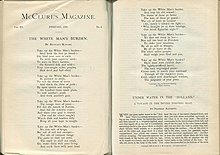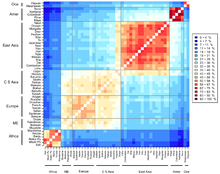"The White Man's Burden: The United States and the Philippine Islands" (1899), by Rudyard Kipling, is a poem about the Philippine–American War (1899–1902), which exhorts the United States to assume colonial control of the Filipino people and their country. Originally written to celebrate the Diamond Jubilee of Queen Victoria (22 June 1897), the jingoistic poem was replaced with the sombre "Recessional" (1897), also a Kipling poem about empire.
In "The White Man's Burden", Kipling encouraged the American annexation and colonization of the Philippine Islands, a Pacific Ocean archipelago conquered in the three-month Spanish–American War (1898). As a pro-imperialist poet, Kipling exhorts the American reader and listener to take up the enterprise of empire, yet warns about the personal costs faced, endured, and paid in building an empire; nonetheless, American imperialists understood the phrase "the white man’s burden" to justify imperial conquest as a mission-of-civilization that is ideologically related to the continental-expansion philosophy of manifest destiny of the early 19th century.
History
"The White Man's Burden: The United States and the Philippine Islands" was first published in The Times (London) on 4 February 1899, and in The New York Sun on 5 February 1899. On 7 February 1899, during senatorial debate to decide if the U.S. should retain control of the Philippine Islands and the ten million Filipinos conquered from the Spanish Empire, Senator Benjamin Tillman read aloud the first, the fourth, and the fifth stanzas of Kipling's seven-stanza poem as arguments against ratification of the Treaty of Paris and in favor of the US formally renouncing claim of authority over the Philippine Islands. To that effect, Senator Tillman addressed the matter to President William McKinley:
As though coming at the most opportune time possible, you might say just before the treaty reached the Senate, or about the time it was sent to us, there appeared in one of our magazines a poem by Rudyard Kipling, the greatest poet of England at this time. This poem, unique, and in some places too deep for me, is a prophecy. I do not imagine that in the history of human events any poet has ever felt inspired so clearly to portray our danger and our duty. It is called "The White Man’s Burden." With the permission of Senators I will read a stanza, and I beg Senators to listen to it, for it is well worth their attention. This man has lived in the Indies. In fact, he is a citizen of the world, and has been all over it, and knows whereof he speaks.
He quotes, inter alia, stanzas 1, 4, and 5 of "The White Man's Burden", noting:
Those [Filipino] peoples are not suited to our institutions. They are not ready for liberty as we understand it. They do not want it. Why are we bent on forcing upon them a civilization not suited to them and which only means in their view degradation and a loss of self-respect, which is worse than the loss of life itself?
Senator Tillman's eloquence was unpersuasive, and the U.S. Congress ratified the Treaty of Paris on 11 February 1899, formally ending the Spanish–American War. After paying a post-war indemnification of twenty million dollars to the Kingdom of Spain, on 11 April 1899 the US established geopolitical hegemony upon islands and peoples in two oceans and in two hemispheres: the Philippine Islands and Guam in the Pacific Ocean, and Cuba and Puerto Rico in the Atlantic Ocean.
Text
Take up the White Man's burden—
Send forth the best ye breed—
Go bind your sons to exile
To serve your captives' need;
To wait in heavy harness
On fluttered folk and wild—
Your new-caught, sullen peoples,
Half devil and half child.
Take up the White Man's burden—
In patience to abide,
To veil the threat of terror
And check the show of pride;
By open speech and simple,
An hundred times made plain.
To seek another's profit,
And work another's gain.
Take up the White Man's burden—
The savage wars of peace—
Fill full the mouth of Famine
And bid the sickness cease;
And when your goal is nearest
The end for others sought,
Watch Sloth and heathen Folly
Bring all your hopes to nought.
Take up the White Man's burden—
No tawdry rule of kings,
But toil of serf and sweeper—
The tale of common things.
The ports ye shall not enter,
The roads ye shall not tread,
Go make them with your living,
And mark them with your dead!
Take up the White Man's burden—
And reap his old reward:
The blame of those ye better,
The hate of those ye guard—
The cry of hosts ye humour
(Ah, slowly!) toward the light:—
"Why brought ye us from bondage,
Our loved Egyptian night?"
Take up the White Man's burden—
Ye dare not stoop to less
Nor call too loud on Freedom
To cloak your weariness;
By all ye cry or whisper,
By all ye leave or do,
The silent, sullen peoples
Shall weigh your Gods and you.
Take up the White Man's burden—
Have done with childish days—
The lightly proffered laurel,
The easy, ungrudged praise.
Comes now, to search your manhood
Through all the thankless years,
Cold-edged with dear-bought wisdom,
The judgment of your peers!
Interpretation
The imperialist interpretation of "The White Man's Burden" (1899) proposes that the white race is morally obliged to civilize the non-white peoples of planet Earth and to encourage their progress (economic, social, and cultural) through colonialism:
The implication, of course, was that the Empire existed not for the benefit—economic or strategic or otherwise—of Britain, itself, but in order that primitive peoples, incapable of self-government, could, with British guidance, eventually become civilized (and Christianized).
Kipling positively represents imperialism as the moral burden of the white race, who are divinely destined to "civilize" the brutish, non-white Other who inhabits the barbarous parts of the world; to wit, the seventh and eighth lines of the first stanza misrepresent the Filipinos as "new-caught, sullen peoples, half-devil and half-child." Despite the chauvinistic nationalism that supported Western imperialism in the 19th century, public moral opposition to Kipling's racist misrepresentation of the colonial exploitation of labor in "The White Man's Burden" produced the satirical essay "To the Person Sitting in Darkness" (1901) by Mark Twain, which catalogues the Western military atrocities of revenge committed against the Chinese people for their anti-colonial Boxer Rebellion (1899–1901) against abusive Western businessmen and Christian missionaries.
Politically, Kipling proffered the poem to then-Governor of New York Theodore Roosevelt, who was a former Assistant Secretary of the Navy and a hero of the Spanish–American War, to help him persuade anti-imperialist Americans to accept the territorial annexation of the Philippine Islands by the United States. In September 1898, Kipling's literary reputation in the U.S. had allowed his promotion of American empire to Roosevelt:
Now, go in and put all the weight of your influence into hanging on, permanently, to the whole Philippines. America has gone and stuck a pick-axe into the foundations of a rotten house, and she is morally bound to build the house over, again, from the foundations, or have it fall about her ears.
Roosevelt sent the poem to U.S. Senator Henry Cabot Lodge, a firm believer in Western imperialism himself, for his review, and they agreed that it made "good sense from the expansion standpoint."
As Victorian imperial poetry, "The White Man's Burden" thematically corresponded to Kipling's belief that the British Empire was the Englishman's "Divine Burden to reign God's Empire on Earth" and celebrates British colonialism as a mission of civilization that eventually would benefit the colonized natives. Since the late nineteenth century, "The White Man's Burden" has served the arguments and counterarguments of supporters and opponents of imperialism and white supremacy.
Responses
In addition to Twain's "To the Person Sitting in Darkness" (1901), a factual satire of the civilizing mission proposed, justified, and defended in "The White Man's Burden" (1899), Kipling's jingoism in the poem provoked numerous poetic parodies in the early 20th century that expressed anti-imperialist moral outrage by critically addressing the white supremacist racism of colonial empires. Among the literary responses to Kipling's work are "The Brown Man's Burden" (February 1899) by the British politician Henry Labouchère, "The Black Man's Burden: A Response to Kipling" (April 1899) by the clergyman H. T. Johnson, and the poem "Take Up the Black Man's Burden" by the American educator J. Dallas Bowser.
In the U.S., a Black Man's Burden Association demonstrated to Americans how the colonial mistreatment of Filipino brown people in their Philippine homeland was a cultural extension of the institutional racism of the Jim Crow laws (1863–1965) for the legal mistreatment of black Americans in their U.S. homeland. The very positive popular response to Kipling's jingoism for an American Empire to annex the Philippines as a colony impelled the growth of the American Anti-Imperialist League to oppose making colonial subjects of the Filipinos.
In The Poor Man’s Burden (1899), Dr. Howard S. Taylor addressed the negative psycho-social effects of the imperialist ethos upon the working-class people in an empire; in "The Real White Man's Burden" (1902), the reformer Ernest Crosby addressed the moral degradation (coarsening of affect) consequent to the practice of imperialism; and in "The Black Man's Burden" (1903), the British journalist E. D. Morel reported the Belgian imperial atrocities in the Congo Free State, which was an African personal property of King Leopold II of Belgium.
In a historical survey of The Black Man's Burden: The White Man in Africa, from the Fifteenth Century to World War I (1920), E. D. Morel's critique of metropole-colony power relations identifies an established cultural hegemony that determines the weight of the black man's burden and the weight of the white man's burden in their building a colonial empire. The philosophic perspective of "The Black Man's Burden (A Reply to Rudyard Kipling)" (1920), by the social critic Hubert Harrison, described the moral degradation inflicted on both the black people who were colonized and the white people who colonized them.
Since the late 20th-century, with the growth of concepts such as decolonization and the developing world, the phrase "the white man's burden" is often used by critics of foreign expansionism and interventionism to illustrate the perceived false good-intentions of Western neo-colonialism for the non-white world and show how the process of "civilizing" indigenous populations is actually part of colonial domination.







































